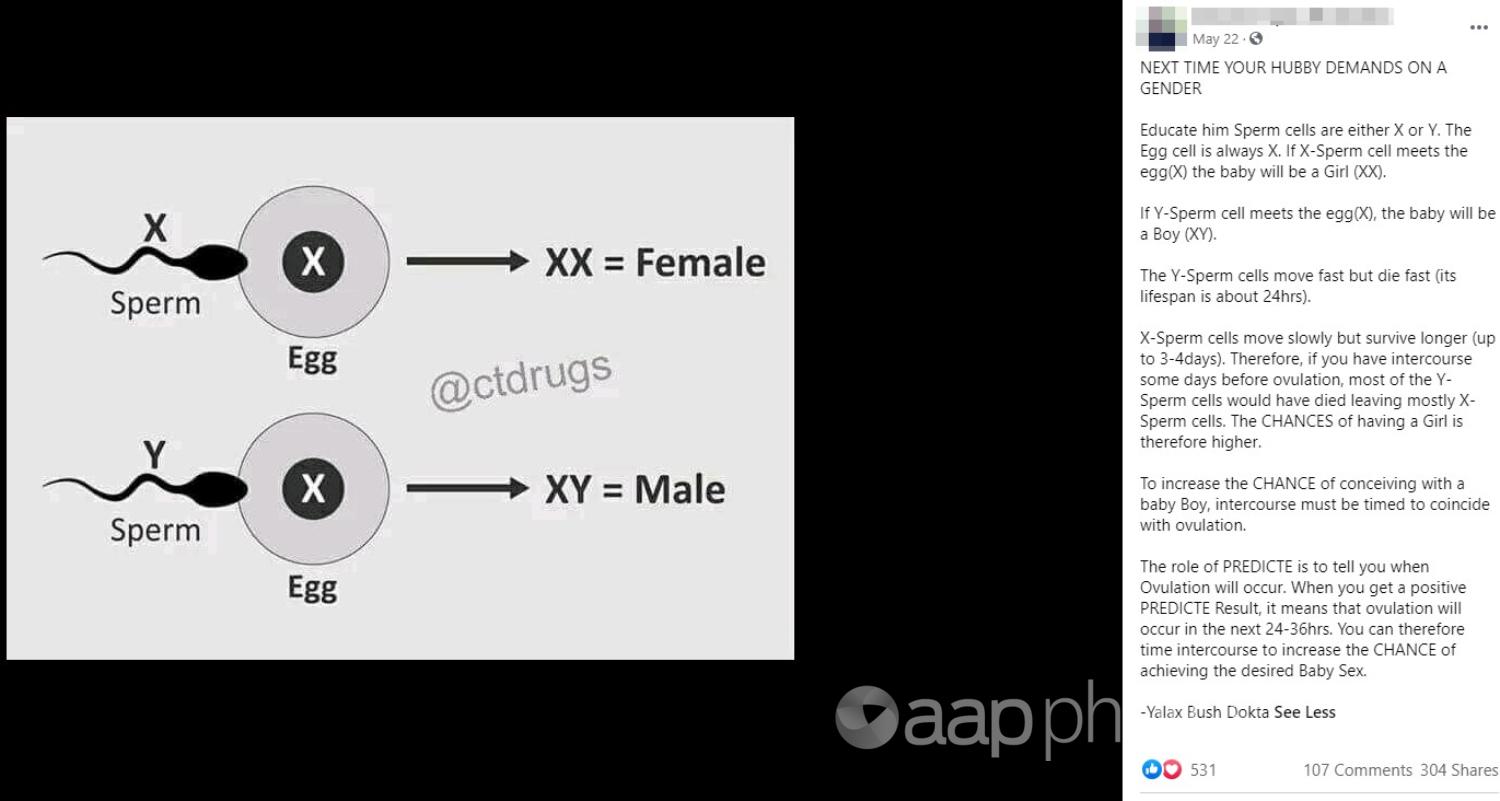The Statement
A Facebook post claims the timing of intercourse can influence the sex of a baby, going on to suggest how readers can increase their chance of the preferred outcome at conception.
The May 22 post from a Papua New Guinea-based account claims sperm cells contain either an X chromosome, which will lead to a girl if it enters the egg, or a Y chromosome, which will result in a boy.
It states Y sperm cells “move fast but die fast”, while X sperm cells “move slowly but survive longer”. It claims that based on this information, people can increase their chances of having a girl with sex several days before ovulation, while for a boy “intercourse must be timed to coincide with ovulation”.
The post recommends people use a product called Predicte to determine the ovulation cycle. The post’s text is very similar to information on the Predicte website.

The Analysis
There have long been claims that the timing of intercourse influences the sex of a baby, however experts say the approach detailed in the post is unsupported by evidence and has been widely discredited.
The method described was developed and popularised by Columbia University fertility doctor Landrum B. Shettles.
According to an article in the Embryo Project Encyclopedia, Dr Shettles developed the “Shettles method” in the 1960s based on his observations that the size, shape and behaviour of sperm cells correlated with the different sex chromosomes they carried.
He believed the differences between the two types of sperm cells could lead to a means of sex selection. He observed that X sperm appeared to survive longer in the acidic conditions normally present in the vagina, while Y sperm swam faster in the alkaline conditions present during ovulation.
He theorised that if couples abstained from intercourse except for the two or three days during and after ovulation, then a boy was more likely. Conversely, if couples had sex at least three days before ovulation, a female baby was more likely.
Some studies have found the timing of intercourse has a statistically significant impact on a baby’s sex, but the results have been conflicting – and many have contradicted the Shettles approach advocated in the post.
A 1979 study study of 3658 births found 65 per cent of babies were male when intercourse resumed two days after ovulation.
However, a number of studies delivered results that conflicted with Shettles’ recommendations (see here, here and here), including a meta-analysis published in the American Journal of Obstetrics and Gynecology, which found males were less likely to be born when conception occurred during ovulation. It said the evidence was “insufficient to allow sex selection by timing of intercourse”.
“This study disproves the suggestion by Shettles and Billings that the selection of male offspring by intercourse around the time of ovulation is possible,” the study said.
Several studies found the timing of intercourse had no significant influence on the sex of a baby for practical purposes (see here and here). One study from Johns Hopkins University researchers looked at 947 births and found “the sex ratio did not vary consistently or significantly with the estimated timing of insemination relative to the day of ovulation”.
“Study findings suggest that manipulating the timing of insemination during the cycle cannot be used to affect the sex of offspring,” it said.
Some studies have also refuted Dr Shettles’ claim that sperm have different physical characteristics.
A 2020 review of studies on the features of X and Y sperm, published in the journal Frontiers in Cell and Development Biology, said that while previous studies had proposed a substantial difference between X and Y spermatozoa, recent studies suggested negligible or no differences in respect to their shape, size, swimming pattern or strength. It said the only difference was their DNA content.
Alex Polyakov, an obstetrician and senior lecturer at the University of Melbourne Medical School, said the claim in the Facebook post was false and the Shettles method was “unsupported by evidence”.
He said while some studies had supported Dr Shettles’ theory that timing intercourse during ovulation resulted in a higher chance of males, other studies had found the opposite – and there was no consistency in the results.
Dr Polyakov said modern microscopes had also shown that Dr Shettles’ theory that X and Y sperm had different attributes was incorrect.
“The whole idea of his that you can time sex and you will get a boy or a girl by doing it is really nonsensical,” he said.
Adelaide Medical School professor Sarah Robertson, an expert on seminal fluid, said there was no evidence that sperm swam at different speeds or died at different rates based on the chromosomes they carried.
She said while it is “not impossible” that the timing of intercourse impacted the ability of Y sperm and X sperm to access and fertilise an egg, “no biological mechanism that affects X sperm versus Y sperm has been reported”.
“In humans, there is no robust clinical evidence that the sex of offspring is affected by timing of intercourse, and no evidence that the survival or fate of Y sperm and X sperm are differentially affected by timing of intercourse in relation to ovulation,” Prof Robertson said.
University of Newcastle professor Brett Nixon, an expert on sperm biology, said the claim in the Facebook post was “very unlikely to be true”, while Monash University senior research fellow Karin Hammarberg, a fertility expert, called its claims “an urban myth”.
The Verdict
There is no clear evidence to support the claim that timing intercourse relative to ovulation can influence the sex of a baby because X and Y sperm behave differently.
While some studies have found the timing of intercourse influences a baby’s sex, the research has also returned conflicting results about what day of conception is more likely to lead to a male or female child. Other studies have found the timing of intercourse has little to no impact on sex. In addition, multiple experts said the method described in the Facebook post has been discredited and is not supported by evidence.
False – Content that has no basis in fact.
* AAP FactCheck is an accredited member of the International Fact-Checking Network. To keep up with our latest fact checks, follow us on Facebook and Twitter.
All information, text and images included on the AAP Websites is for personal use only and may not be re-written, copied, re-sold or re-distributed, framed, linked, shared onto social media or otherwise used whether for compensation of any kind or not, unless you have the prior written permission of AAP. For more information, please refer to our standard terms and conditions.


















